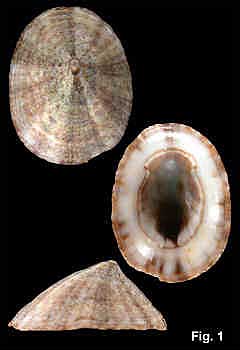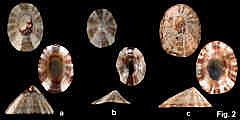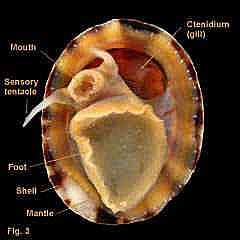|
|
|
|
|
Patelloida mimula (Iredale, 1924) Description: Shape, sculpture and colouration variable. Shell flat to tall, anterior and posterior slopes straight or concave; widest centrally or slightly posteriorly; apex in front of centre. Exterior usually eroded. Exterior colouration often of radial dark bands, widening towards margin, sometimes forming a Maltese cross; non-eroded shells show blue dots microscopically. Interior irregularly coloured with brown and white, or with exterior bands showing through. Spatula either well or poorly defined. Margin smooth or weakly crenulate internally. Size: Up to 21 mm in length, commonly 10-15 mm. Distribution: Endemic to Australia: Shark Bay, WA, around northern Australia to Lakes Entrance, Victoria. Habitat: Sheltered habitats in estuaries, usually living on the oyster Saccostrea cuccullata, and among mangrove roots, from mid to low tide level. Abundant. Minchinton & Ross (1999) studied how this limpet lives on oysters in a mangrove forest in Botany Bay. The main areas of hard substrate in the forest are oysters and mangrove tree trunks; they found the limpets almost entirely on the oysters. There is usually only one limpet per oyster. The limpets create a home scar on the oysters, and appear to be restricted to a single oyster as a territory. Tracking of individual limpets for 13 days showed that 70% remained on the same oyster, presumably moving on when the microalgal food supply on the oyster surface had been consumed. Comparison: See Patelloida mufria. Synonymy: Patella jacksoniensis Reeve, 1855; Notoacmea mixta mimula Iredale, 1924; Chiazacmea flammea queenslandica Oliver, 1926; Patelloida flammea marrowi Christiaens, 1975 Remarks: Ponder & Creese (1980) described this species as smooth, in contrast to P. mufria which is radially ribbed. However, under magnification, unworn specimens of P. mimula show concentric growth lamellae, sometimes weak radial ribs, and are marked with blue spots. Fig. 1 Barrenjoey, Pittwater, NSW (DLB5091) Fig. 2 a. Middle Harbour, NSW (DLB5090) b. Pittwater, NSW (DLB5089) c. Lane Cove River, NSW (C.173692) Fig. 3 Live animal. Middle Harbour, NSW (DLB5084) |


